Abstract
It is well known that ubiquinone-10 (coenzyme Q10, ubiquinone 50) acts as an electron carrier of the respiratory chain in mitochondria. In this paper we show that ubiquinol-10, the reduced form of ubiquinone-10, also efficiently scavenges free radicals generated chemically within liposomal membranes. Ubiquinol-10 is about as effective in preventing peroxidative damage to lipids as alpha-tocopherol, which is considered the best lipid-soluble antioxidant in humans. The number of radicals scavenged by each molecule of ubiquinol-10 is 1.1 under our experimental conditions. In contrast to alpha-tocopherol, ubiquinol-10 is not recycled by ascorbate. However, it is known that ubiquinol-10 can be recycled by electron transport carriers present in various biomembranes and possibly by some enzymes. We also show that ubiquinol-10 spares alpha-tocopherol when both antioxidants are present in the same liposomal membranes and that ubiquinol-10, like alpha-tocopherol, does not interact with reduced glutathione. Our data together with previous work on the antioxidant function of ubiquinol reported in the literature strongly suggest that ubiquinol-10 is an important physiological lipid-soluble antioxidant.
Full text
PDF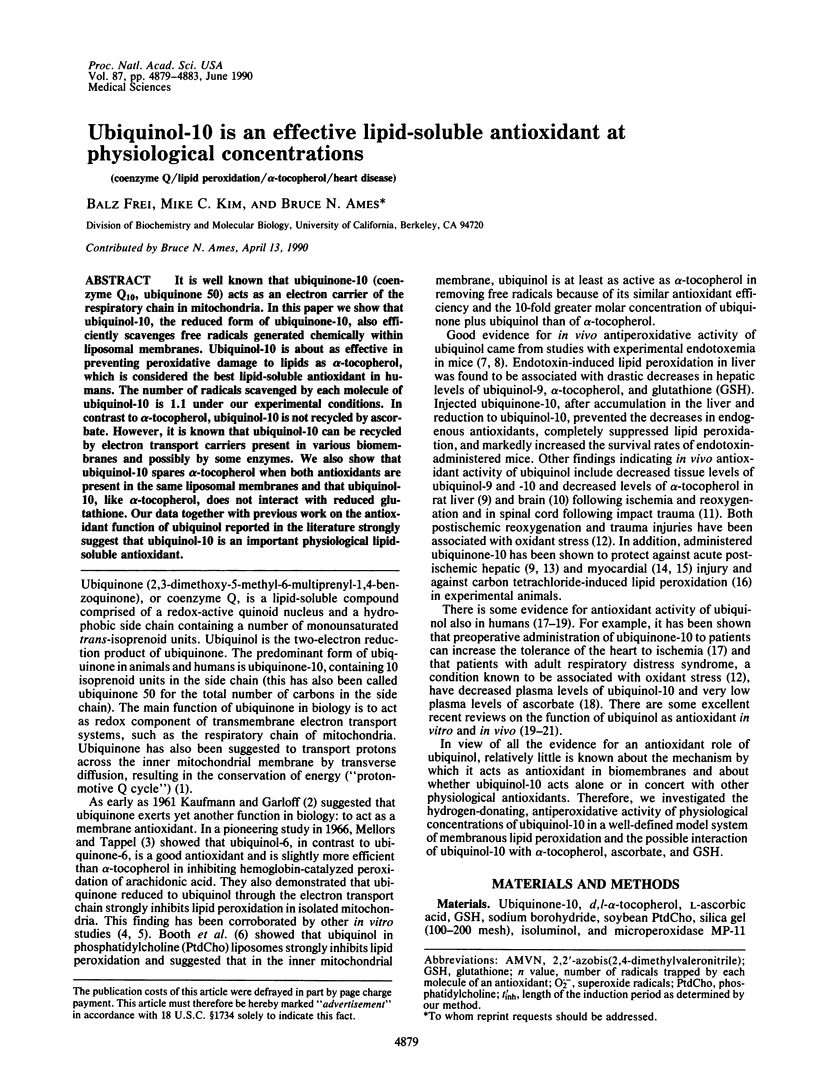
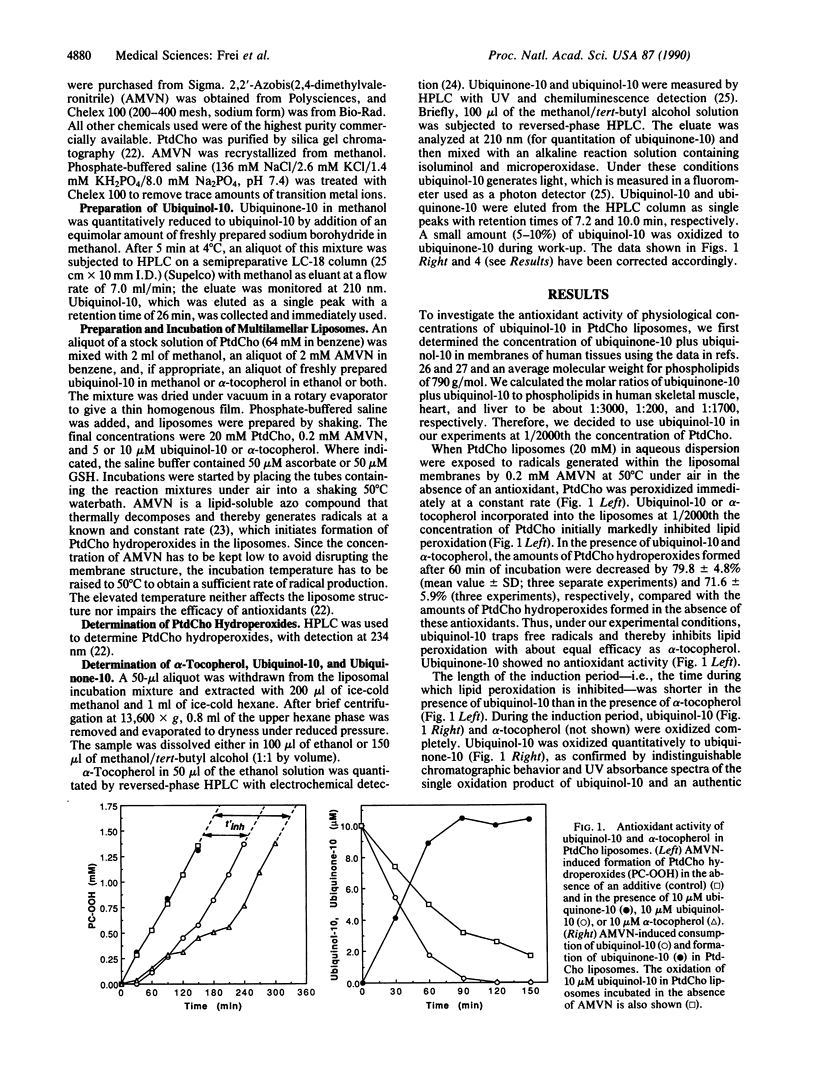
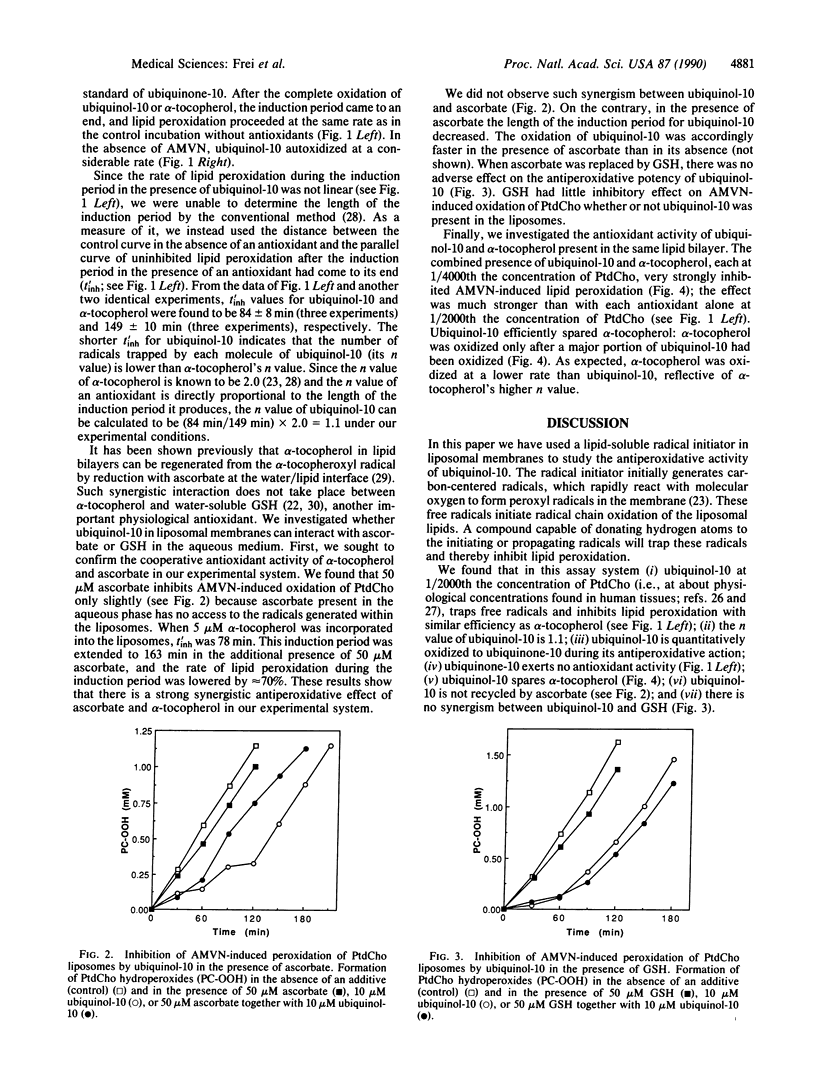
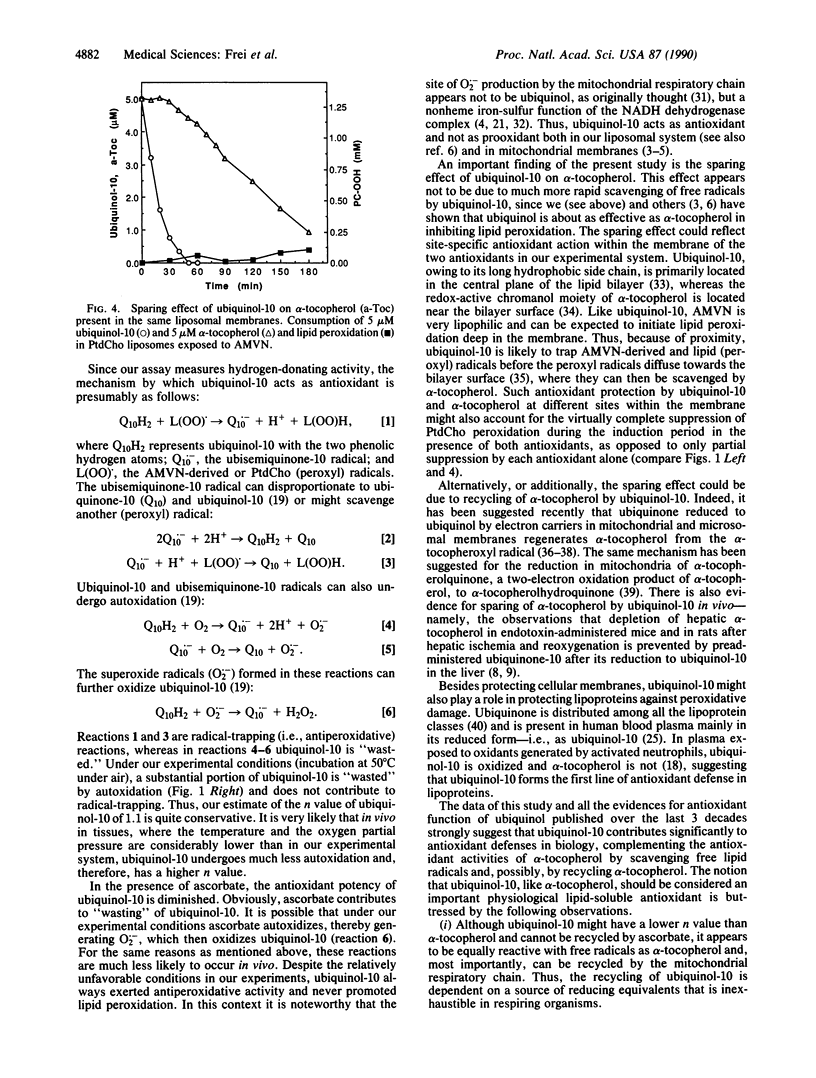
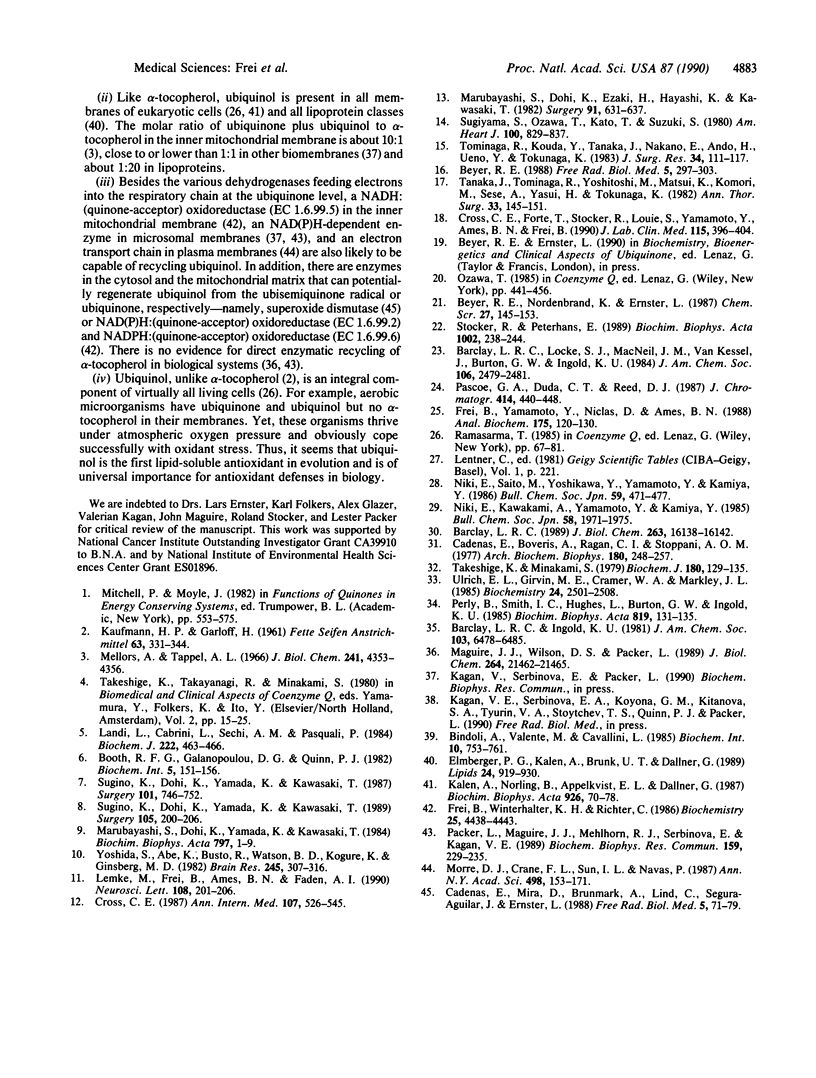
Selected References
These references are in PubMed. This may not be the complete list of references from this article.
- Barclay L. R. The cooperative antioxidant role of glutathione with a lipid-soluble and a water-soluble antioxidant during peroxidation of liposomes initiated in the aqueous phase and in the lipid phase. J Biol Chem. 1988 Nov 5;263(31):16138–16142. [PubMed] [Google Scholar]
- Beyer R. E. Inhibition by coenzyme Q of ethanol- and carbon tetrachloride-stimulated lipid peroxidation in vivo and catalyzed by microsomal and mitochondrial systems. Free Radic Biol Med. 1988;5(5-6):297–303. doi: 10.1016/0891-5849(88)90100-1. [DOI] [PubMed] [Google Scholar]
- Bindoli A., Valente M., Cavallini L. Inhibition of lipid peroxidation by alpha-tocopherolquinone and alpha-tocopherolhydroquinone. Biochem Int. 1985 May;10(5):753–761. [PubMed] [Google Scholar]
- Cadenas E., Boveris A., Ragan C. I., Stoppani A. O. Production of superoxide radicals and hydrogen peroxide by NADH-ubiquinone reductase and ubiquinol-cytochrome c reductase from beef-heart mitochondria. Arch Biochem Biophys. 1977 Apr 30;180(2):248–257. doi: 10.1016/0003-9861(77)90035-2. [DOI] [PubMed] [Google Scholar]
- Cadenas E., Mira D., Brunmark A., Lind C., Segura-Aguilar J., Ernster L. Effect of superoxide dismutase on the autoxidation of various hydroquinones--a possible role of superoxide dismutase as a superoxide:semiquinone oxidoreductase. Free Radic Biol Med. 1988;5(2):71–79. doi: 10.1016/0891-5849(88)90032-9. [DOI] [PubMed] [Google Scholar]
- Cross C. E., Forte T., Stocker R., Louie S., Yamamoto Y., Ames B. N., Frei B. Oxidative stress and abnormal cholesterol metabolism in patients with adult respiratory distress syndrome. J Lab Clin Med. 1990 Apr;115(4):396–404. [PubMed] [Google Scholar]
- Cross C. E., Halliwell B., Borish E. T., Pryor W. A., Ames B. N., Saul R. L., McCord J. M., Harman D. Oxygen radicals and human disease. Ann Intern Med. 1987 Oct;107(4):526–545. doi: 10.7326/0003-4819-107-4-526. [DOI] [PubMed] [Google Scholar]
- Elmberger P. G., Kalén A., Brunk U. T., Dallner G. Discharge of newly-synthesized dolichol and ubiquinone with lipoproteins to rat liver perfusate and to the bile. Lipids. 1989 Nov;24(11):919–930. doi: 10.1007/BF02544535. [DOI] [PubMed] [Google Scholar]
- Frei B., Winterhalter K. H., Richter C. Menadione- (2-methyl-1,4-naphthoquinone-) dependent enzymatic redox cycling and calcium release by mitochondria. Biochemistry. 1986 Jul 29;25(15):4438–4443. doi: 10.1021/bi00363a040. [DOI] [PubMed] [Google Scholar]
- Frei B., Yamamoto Y., Niclas D., Ames B. N. Evaluation of an isoluminol chemiluminescence assay for the detection of hydroperoxides in human blood plasma. Anal Biochem. 1988 Nov 15;175(1):120–130. doi: 10.1016/0003-2697(88)90369-7. [DOI] [PubMed] [Google Scholar]
- Kalén A., Norling B., Appelkvist E. L., Dallner G. Ubiquinone biosynthesis by the microsomal fraction from rat liver. Biochim Biophys Acta. 1987 Oct 8;926(1):70–78. doi: 10.1016/0304-4165(87)90183-8. [DOI] [PubMed] [Google Scholar]
- Landi L., Cabrini L., Sechi A. M., Pasquali P. Antioxidative effect of ubiquinones on mitochondrial membranes. Biochem J. 1984 Sep 1;222(2):463–466. doi: 10.1042/bj2220463. [DOI] [PMC free article] [PubMed] [Google Scholar]
- Lemke M., Frei B., Ames B. N., Faden A. I. Decreases in tissue levels of ubiquinol-9 and -10, ascorbate and alpha-tocopherol following spinal cord impact trauma in rats. Neurosci Lett. 1990 Jan 1;108(1-2):201–206. doi: 10.1016/0304-3940(90)90731-n. [DOI] [PubMed] [Google Scholar]
- Maguire J. J., Wilson D. S., Packer L. Mitochondrial electron transport-linked tocopheroxyl radical reduction. J Biol Chem. 1989 Dec 25;264(36):21462–21465. [PubMed] [Google Scholar]
- Marubayashi S., Dohi K., Ezaki H., Hayashi K., Kawasaki T. Preservation of ischemic rat liver mitochondrial functions and liver viability with CoQ10. Surgery. 1982 Jun;91(6):631–637. [PubMed] [Google Scholar]
- Marubayashi S., Dohi K., Yamada K., Kawasaki T. Changes in the levels of endogenous coenzyme Q homologs, alpha-tocopherol, and glutathione in rat liver after hepatic ischemia and reperfusion, and the effect of pretreatment with coenzyme Q10. Biochim Biophys Acta. 1984 Jan 24;797(1):1–9. [PubMed] [Google Scholar]
- Mellors A., Tappel A. L. The inhibition of mitochondrial peroxidation by ubiquinone and ubiquinol. J Biol Chem. 1966 Oct 10;241(19):4353–4356. [PubMed] [Google Scholar]
- Morré D. J., Crane F. L., Sun I. L., Navas P. The role of ascorbate in biomembrane energetics. Ann N Y Acad Sci. 1987;498:153–171. doi: 10.1111/j.1749-6632.1987.tb23759.x. [DOI] [PubMed] [Google Scholar]
- Packer L., Maguire J. J., Mehlhorn R. J., Serbinova E., Kagan V. E. Mitochondria and microsomal membranes have a free radical reductase activity that prevents chromanoxyl radical accumulation. Biochem Biophys Res Commun. 1989 Feb 28;159(1):229–235. doi: 10.1016/0006-291x(89)92427-3. [DOI] [PubMed] [Google Scholar]
- Pascoe G. A., Duda C. T., Reed D. J. Determination of alpha-tocopherol and alpha-tocopherylquinone in small biological samples by high-performance liquid chromatography with electrochemical detection. J Chromatogr. 1987 Mar 6;414(2):440–448. doi: 10.1016/0378-4347(87)80071-3. [DOI] [PubMed] [Google Scholar]
- Perly B., Smith I. C., Hughes L., Burton G. W., Ingold K. U. Estimation of the location of natural alpha-tocopherol in lipid bilayers by 13C-NMR spectroscopy. Biochim Biophys Acta. 1985 Sep 25;819(1):131–135. doi: 10.1016/0005-2736(85)90203-2. [DOI] [PubMed] [Google Scholar]
- Stocker R., Peterhans E. Synergistic interaction between vitamin E and the bile pigments bilirubin and biliverdin. Biochim Biophys Acta. 1989 Apr 3;1002(2):238–244. doi: 10.1016/0005-2760(89)90293-2. [DOI] [PubMed] [Google Scholar]
- Sugino K., Dohi K., Yamada K., Kawasaki T. Changes in the levels of endogenous antioxidants in the liver of mice with experimental endotoxemia and the protective effects of the antioxidants. Surgery. 1989 Feb;105(2 Pt 1):200–206. [PubMed] [Google Scholar]
- Sugino K., Dohi K., Yamada K., Kawasaki T. The role of lipid peroxidation in endotoxin-induced hepatic damage and the protective effect of antioxidants. Surgery. 1987 Jun;101(6):746–752. [PubMed] [Google Scholar]
- Sugiyama S., Ozawa T., Kato T., Suzuki S. Recovery time course of ventricular vulnerability after coronary reperfusion in relation to mitochondrial function in ischemic myocardium. Am Heart J. 1980 Dec;100(6 Pt 1):829–837. doi: 10.1016/0002-8703(80)90063-0. [DOI] [PubMed] [Google Scholar]
- Takeshige K., Minakami S. NADH- and NADPH-dependent formation of superoxide anions by bovine heart submitochondrial particles and NADH-ubiquinone reductase preparation. Biochem J. 1979 Apr 15;180(1):129–135. doi: 10.1042/bj1800129. [DOI] [PMC free article] [PubMed] [Google Scholar]
- Tanaka J., Tominaga R., Yoshitoshi M., Matsui K., Komori M., Sese A., Yasui H., Tokunaga K. Coenzyme Q10: the prophylactic effect on low cardiac output following cardiac valve replacement. Ann Thorac Surg. 1982 Feb;33(2):145–151. doi: 10.1016/s0003-4975(10)61900-5. [DOI] [PubMed] [Google Scholar]
- Tominaga R., Kouda Y., Tanaka J., Nakano E., Ando H., Ueno Y., Tokunaga K. Effects of pretreatment with coenzyme Q10 on myocardial preservation during aortic cross clamping. J Surg Res. 1983 Feb;34(2):111–117. doi: 10.1016/0022-4804(83)90049-5. [DOI] [PubMed] [Google Scholar]
- Ulrich E. L., Girvin M. E., Cramer W. A., Markley J. L. Location and mobility of ubiquinones of different chain lengths in artificial membrane vesicles. Biochemistry. 1985 May 7;24(10):2501–2508. doi: 10.1021/bi00331a016. [DOI] [PubMed] [Google Scholar]
- Yoshida S., Abe K., Busto R., Watson B. D., Kogure K., Ginsberg M. D. Influence of transient ischemia on lipid-soluble antioxidants, free fatty acids and energy metabolites in rat brain. Brain Res. 1982 Aug 12;245(2):307–316. doi: 10.1016/0006-8993(82)90813-7. [DOI] [PubMed] [Google Scholar]


